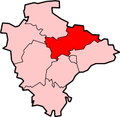| Clayhanger | |
|---|---|
 A lane in the village | |
Location within Devon | |
| Population | 127 (2011 UK Census) |
| OS grid reference | ST022230 |
| District | |
| Shire county | |
| Region | |
| Country | England |
| Sovereign state | United Kingdom |
| Post town | TIVERTON |
| Postcode district | EX16 7N |
| Police | Devon and Cornwall |
| Fire | Devon and Somerset |
| Ambulance | South Western |
| UK Parliament | |
Clayhanger is a hamlet and civil parish in the Mid Devon district of Devon, England. [1] [2] At the time of the 2011 census it had a population of 127. [3]

